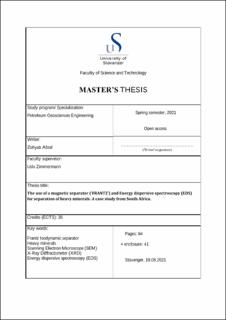| dc.description.abstract | A detail study on three selected samples is applied to dispatch the of effectiveness of Frantz isodynamic separator for separation of heavy minerals. Samples selected for study are amphibolite, phyllite and lava from Rosh Pinah Formation, Grootderm Formation and Vredefontein Formation respectively. The selected samples contains only magnetic fraction of heavy minerals, whereas the non-magnetic fractions was removed by Geotrack international, Australia at 25º forward slope and 2º side slope on full Frantz scale. Separation of minerals in Frantz isodynamic separator for three different grain sizes (for each sample) is carried out at magnetic field strength ranging from 0.1 A to 0.4 A keeping 25º forward slope and 15º side slope. The minerals in Frantz separated fractions are identified using FE-SEM-EDS analysis. Generally, amphibolite has low amount of quartz compare to phyllite and lava. The dominant amount of quartz, albite and feldspar in lava indicates felsic to intermediate composition.
The analysis of Frantz separated fractions shows that, light minerals such as quartz, albite, anorthite and other occurs as relict of magnetic separation. The dominance of these minerals in magnetic fractions is attributed chiefly to presence of lithoclasts in the samples. The comparison of heavy mineral concentration in different lithologies suggest that some of heavy minerals such as hematite, tin bearing hematite, almandine, occurs in all lithologies in different grain sizes. Furthermore, there occurrence is not restricted to specific magnetic fraction instead they have range of extraction. Mostly these mineral lies in expected range of extraction except few cases where they are found in other magnetic fractions. Rutile, a high temperature mineral and is abundant in amphibolite suggesting high pressure temperature condition. Goethite is dominantly found in phyllites indicating chemical weathering. Rutile also shows abundance in all magnetic fractions, making it difficult to define exact range of extraction.
The presence of some non-magnetic mineral such as apatite-F, zircon, monzonite, barite and titanite in samples and their occurrence in magnetic fractions retained at low magnetic field strength indicates separation of non-magnetic fraction done by Geotrack international, Australia was not fully effective. The reason could be occurrence of these minerals in the form of locked grains with other paramagnetic minerals. The tourmaline among all the heavy minerals shows most effective separation for grain size >150 μm and for un-sieved fraction, however the high amount of lithoclasts in grain size >250 μm could be the reason of effecting the separation in this grain size. Certain heavy minerals such as tourmaline, monzonite, titanite and barite are limited to phyllite and lava only indicating possibility of extraction of determining heavy minerals for correlation. | |
